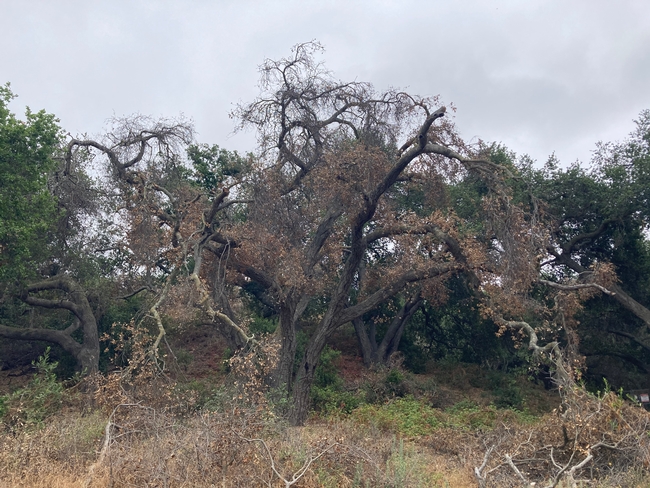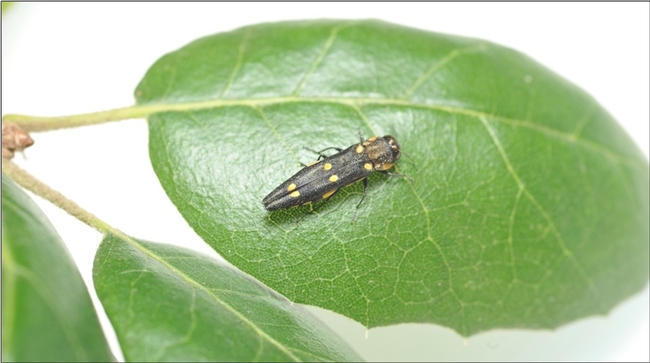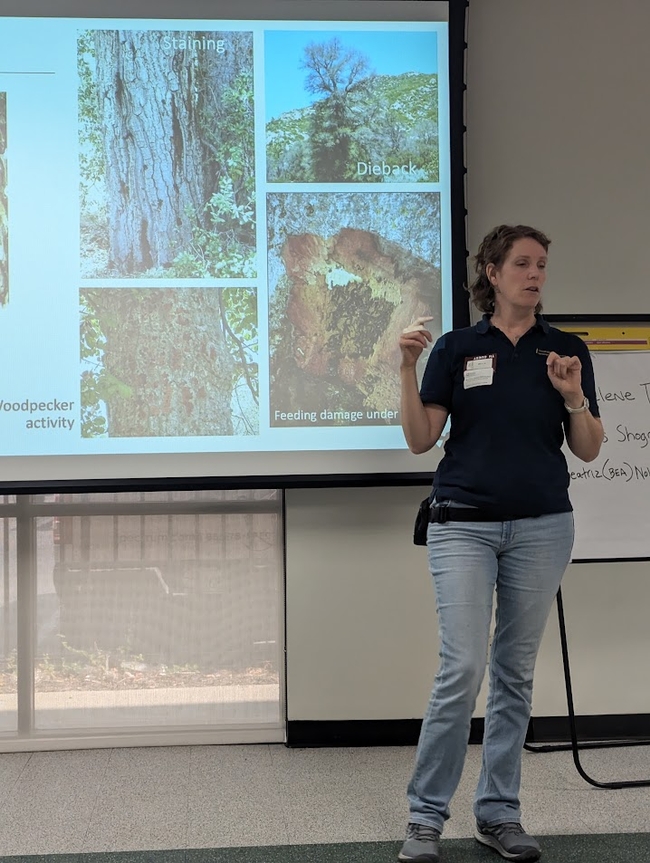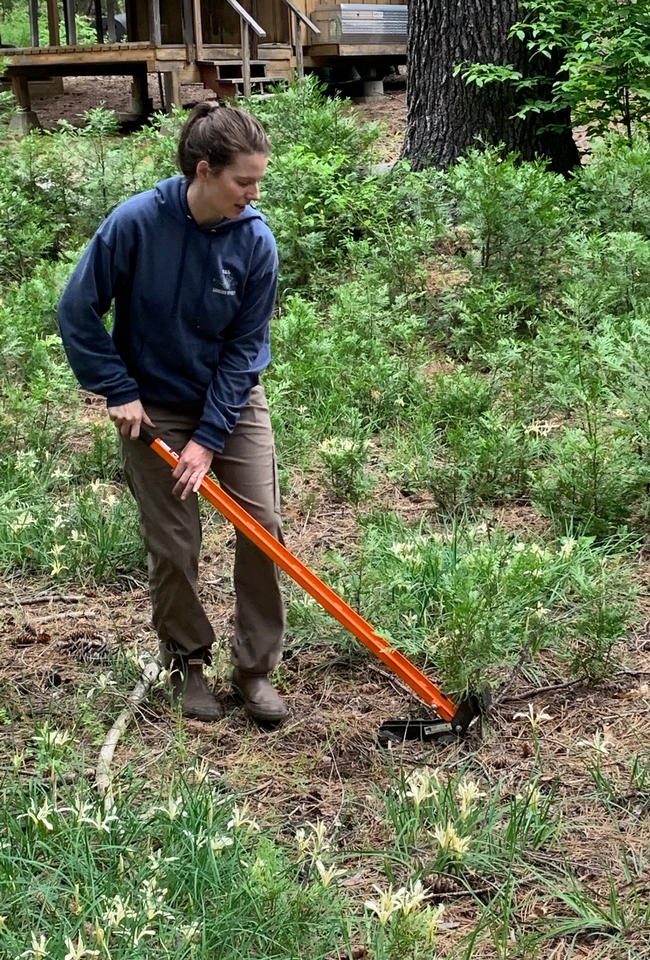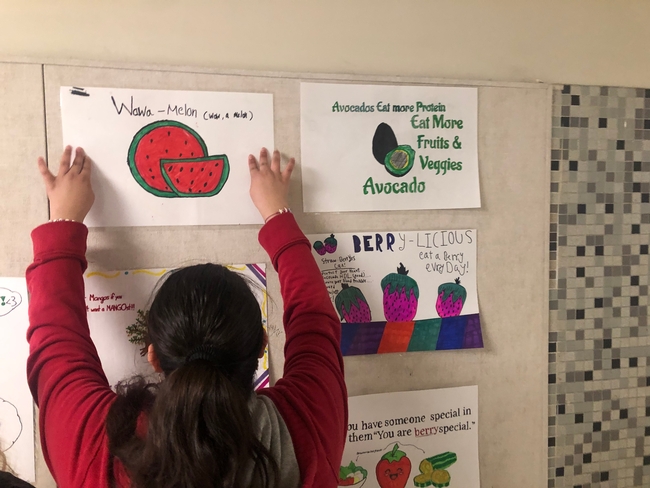- Author: Beatriz Nobua-Behrmann
SoCal Edison staff, bolstered with UCCE training, identify Goldspotted Oak Borer infestations and trigger swift response, demonstrating enhanced workforce capacity to combat invasive species and protect California's forests.
The Issue
Invasive tree pests pose a significant threat to California's urban and natural forests. Among them, the goldspotted oak borer (GSOB) has inflicted severe damage on the state's oak populations, resulting in substantial tree mortality and altering forest ecosystems. This invasive beetle primarily targets coast live oaks, California black oaks, and canyon live oaks. The decline of these iconic trees disrupts natural habitats and negatively impacts local economies that rely on healthy forests for recreation, tourism, and timber resources. As new infestations continue to rise in Los Angeles and Orange Counties, timely identification and management are crucial for safeguarding oak forests and their associated wildlife. There is an urgent need to both partner with those regularly inspecting trees and provide opportunities to enhance workforce competency in pest management.
How UC Delivers
To address this pressing issue, a collaborative team from University of California Cooperative Extension (UCCE) partnered with SoCal Edison (SCE) to organize a comprehensive four-hour training session in July 2024. This session brought together 57 participants, including staff and contractors from SCE, at the company's offices in Irwindale. Instructors included UCCE Advisors Beatriz Nobua-Behrmann and Chris Shogren, along with Joelene Tramm, the Natural Resources Director for the La Jolla Band of Indians and a master's student in Entomology at UC Riverside. Randall Oliver (UC Integrated Pest Management) and Julie Clark (UCCE Ventura County) provided logistical support to make this happen.
The training equipped participants with essential skills for identifying GSOB infestations, implementing effective management strategies, and preventing the pest's spread by properly disposing of infested plant material. It featured real-world examples of successful management practices and the latest research findings. In addition to GSOB, the agenda included training on identifying other critical tree pests and diseases. Participants engaged in interactive discussions, fostering a community of practice focused on protecting California's forests.
The Impact
The impact of this training was immediate and measurable. Within two months of the session, SCE staff reported two new suspected GSOB infestations in previously unknown locations. Armed with the knowledge gained from UCCE, they promptly initiated best management practices. Once our UCCE team was informed of these suspected infestations, we coordinated a collaborative response involving agencies such as CalFIRE, the Inland Empire Resource Conservation District, LA County Fire, and the US Forest Service. This swift action not only confirmed the new infestations but also established a solid foundation for strategic interventions.
Feedback from the training highlighted its effectiveness: 60% of attendees completed a post-training survey, with all respondents unanimously expressing increased confidence in identifying and managing tree pests and a commitment to applying their newly found knowledge. By empowering SCE staff and contractors with essential training, UC ANR has strengthened California's workforce competency and enhanced the state's capacity to combat invasive species and protect its natural resources.
Looking ahead, the collaboration between UCCE and SCE is set to continue, with plans for ongoing training sessions and resources to support pest detection efforts across Southern California. The success of this initiative underscores the importance of partnerships in addressing environmental challenges, providing a model for future interventions.
“Through UCCE training and SCE collaboration, we have been able to collectively expand inspection horizons throughout SCE utility corridors that has helped discover new distribution patterns”- Chul Paik, SCE Senior Specialist
In conclusion, through targeted training and collaborative action, UCCE is making significant strides in safeguarding California's natural resources while enhancing workforce competency in invasive species management. This proactive approach not only benefits the immediate environment but also fortifies the resilience of California's forests for generations to come.

- Author: Reka Vasicsek
- Author: Carolyn Rider
Local Health Departments are improving their CFHL programs using the Nutrition Policy Institute's LEAP awards. Three hundred thirty-three schools and programs were recognized across California for making strides on health and wellness practices.
The Issue
Establishing healthy eating and physical activity practices during childhood has become a priority in education and policy. Promoting nutrition and physical activity best practices in school and childcare programs is key to ensuring the next generation of Californians grows into healthy, active adults.
How UC Delivers
The University of California's Nutrition Policy Institute (NPI), in collaboration with the California Department of Public Health's CalFresh Healthy Living (CFHL) program, coordinates evaluation in schools, early care and education centers, and out-of-school time programs to assess nutrition and physical activity policies and practices. NPI's Site-Level Assessment Questionnaires (SLAQs) are used to assess programs and support plans for program development and improvement. CFHL programs target schools and childcare programs in low-income communities to create health-promoting environments for children.
“Thank you for sharing this! I am meeting with my team next week to discuss our school approach for FY24 and this will be super helpful to help identify new/expanded areas for working with the schools.”
- Local Health Department CFHL Project Director
NPI launched the Leaders in Eating and Activity Practices (LEAP) program in 2023, recognizing 131 schools, 124 early care and education programs, and 78 out-of-school time programs across California for achieving best practices in healthy eating and active living. All 333 sites received recognition in one or more specific areas: nutrition, physical activity, gardens, or breastfeeding support. Additionally, 38 sites were awarded gold, silver, or bronze for comprehensive achievement of overall nutrition and physical activity practices.To receive a LEAP award, sites reported wellness practices on a SLAQ and partnered with their Local Health Department's CFHL program to plan and implement health promotion projects. These projects target a range of children's nutrition and physical activity behaviors by changing policies, systems, and the environment at schools and childcare programs. NPI provided LEAP winners with personalized certificates and a digital promotions package to help them promote their achievement through social media, newsletters, or other media.
“Oh how exciting! Especially since we may be working more closely with middle schools in FY24-26 and this recognition might just encourage them join on for more PSE [policy, systems, and environmental change] focused work.”
- Local Health Department CFHL Project Director
The Impact
LEAP recognition of successful wellness programs can invigorate partnerships and inspire more impactful work. LEAP aims to motivate schools and childcare programs to implement comprehensive, evidence-based strategies to improve child health outcomes. The program also encourages Local Health Departments and their partners to promote their wellness efforts among families and community members, building community awareness of and support for CFHL. Within six months of launching the program, two-thirds of surveyed Local Health Departments reported utilizing the LEAP digital promotions package to promote their partners' healthy eating and physical activity interventions and 22% reported utilizing the LEAP award criteria to inform intervention planning at their partner sites. LEAP awardees and LHD partners have been featured on social media and in community newsletters, newspaper articles, and press releases, enhancing public awareness of CalFresh Healthy Living and UC's Nutrition Policy Institute.
Testimonials from Local Health Department CFHL Project Directors:
“I'm thrilled for our schools and extra excited for the Gold Award!! I can't wait to celebrate ourschools and the fabulous work they are doing. THANK YOU so much for this.”

This family childcare home gained LEAP recognition with a Gold Award and all four badges (Nutrition, Physical Activity, Gardens, and Breastfeeding Support).
“I never thought I would be serving asparagus to the kids. I had a hard time getting them to even eat fruits! After doing all the garden activities, they became more excited and more adventurous to try new foods. They were also very excited to check on their plants every day. They tell me they can't wait to eat the stuff they are growing.”
-Dulce Gaytan, Childcare Provider
- Author: Alexa Erickson
- Contact: Tuline N Baykal
- Contributor: Max Fairbee
CalFresh Healthy Living, UCCE and Master Gardeners in Alameda County promote healthy people and communities: Working with South County Homeless Project residents to grow fresh vegetables in a therapeutic green space.
The Issue
California has one of the highest populations of unhoused people in the nation - 44 out of every 10,000 people do not have stable housing. Being unhoused is strongly tied to food insecurity, including a lack of access to fresh foods and preferred fruits and vegetables. South County Homeless Project is a 24-bed residence for individuals experiencing homelessness. Residents stay from three months to a year and receive support in finding employment and permanent housing. The residence is equipped with a therapeutic garden space, but at the beginning of 2023, it had been overgrown after years of disuse.

How UC Delivers
When Alameda County CalFresh Healthy Living, UCCE decided to restart their adult garden nutrition programming, the neglected garden space at South County Homeless Project presented itself as a great place to start. A nutrition educator who had provided nutrition classes at the site for nearly six years led the collaboration to renovate the large garden onsite. Invaluable support for the garden came from Alameda County Master Gardener's (ACMG) Community Garden Team, who designed the garden and enlisted volunteers to evaluate and amend the existing soil. CFHL, UCCE supplied soil while ACMG provided seedlings. Master Gardeners also lent their expertise to the residents with the workshop, “Gardening Basics”. The nutrition educator, residents, and ACMG volunteers worked together to plant the garden. The team planted 19 varieties of vegetables, fruits, and herbs. As the garden grew, nutrition classes continued with the curriculum, “Fresh from the Garden.” Food from the garden was harvested regularly and enjoyed fresh by residents and incorporated by the chef into house meals.
"One of the chef's used the zucchini in the pasta sauce, it was so good! I didn't really know you could use it that way!" -Resident


The Impact
Residents and staff completed a brief written questionnaire. Ten residents participated in the “Fresh from the Garden” classes at the time of the garden renovations. New residents take part in ongoing garden education, and many residents and staff have increased their use of the space. Those who participated in gardening reported benefits such as learning new ways of preparing and eating local, seasonal vegetables and increased acceptance or awareness of different produce. The food grown in the garden was among the most popular benefits of the garden; the staff chef said that they were able to incorporate many vegetables from the garden into house meals. Residents and staff also stated that being in the garden helped reduce stress and that it was nice to spend time in a peaceful space.
"(The garden) relaxes me from stress. I love the garden." -Resident gardener
The transformation of the yard into a peaceful green space will continue to benefit current and future residents. Those who choose to garden can experience the physical and mental benefits of gardening, such as increased strength and social connection. For residents not interested in or unable to participate in gardening, simply spending time in a green space can have many positive effects on well-being. And by involving residents in planning what vegetables and fruits are planted, they can regain agency over food choice that is often lacking when experiencing homelessness. Overall, the garden renovation and classes connect to the UC ANR public value of promoting healthy people and communities and the condition change "improved community health and wellness" as well as "improved access to positive built and natural environments".

Currently, in April 2024, the garden beds are being prepped and planted with a new group of residents. Seedlings will be planted in April and May. Looking forward, the goals for the garden include adding irrigation to make maintenance much easier. Garden organizers hope to host a Master Food Preservers workshop to help residents learn to process and store produce. Given the success of South County Homeless Project's garden, the CFHL team hopes to bring gardens to similar sites throughout the county as part of the program's adult and senior garden initiative. Another longer-term goal of the initiative is to develop a certificate or training program where residents can receive credits for working in the garden.
"I love the garden and when the cook cooks the vegetables, they taste amazing. I am thankful for this garden and for having the CalFresh Healthy Living team...thank you." -Resident gardener
References
- Thompson R. (2018). Gardening for health: a regular dose of gardening. Clinical medicine (London, England), 18(3), 201–205. https://www.ncbi.nlm.nih.gov/pmc/articles/PMC6334070/
- Easton, Corinna, et al. "The experience of food insecurity during and following homelessness in high-income countries: A systematic review and meta-aggregation." Health & Social Care in the Community 30.6 (2022): e3384-e3405. https://onlinelibrary.wiley.com/doi/10.1111/hsc.13939
- The 2022 Annual Homelessness Assessment Report (AHAR) to Congress. Department of Housing and Urban Development Data. https://www.huduser.gov/portal/sites/default/files/pdf/2022-AHAR-Part-1.pdf
- Author: Kimberly C Ingram
Social Media Summary
Protecting California's forests and building climate-resilient communities and ecosystems requires forest landowners, managers, and natural resource professionals to actively engage in stewardship. UC ANR's Forest Stewardship Education Initiative provides practical forest management information and hands-on skills to small forest landowners throughout California's forested communities. Since 2020, 100 landowners who attended a 9-week Forest Stewardship Workshop series, have had an initial site visit with a Registered Professional Forester or engaged other natural resource professionals to walk their land, discuss their objectives, and identify activities that will help them reach their goals to improve forest management. Together, these landowners manage over 10,000 acres in California.
The Issue
The operational environment for managing forestland in California is challenging, especially for the ~75,000 forest landowners owning 10 or more acres. Current infrastructure and resources tend to more positively support large or industrial forest landowners. Survey data of Forest Stewardship participants identify cost, time, and lack of a qualified workforce as the biggest barriers to implementing forest management activities. Providing forest landowners with the tools they need to develop a management plan, engage a resource professional, and apply for cost-share funding, will help eliminate barriers to implementing their management goals, and address threats to California's forests, such as increasing wildfires and droughts due to climate change.
How UC Delivers
Since 2020, 485 participants have completed 24 Forest Stewardship Workshops across the state. The workshops are offered through a hybrid learning style involving online learning assignments, nine weeks of evening zoom meetings, and one in-person field day to view various silvicultural methods and build hands-on forestry skills including inventory, mapping, and plant identification. Additionally, we focus participants on drafting sections of the California Cooperative Forest Management Plan (CCFMP), which can make them eligible for state and federal cost-share programs. Just over half of registered participants (53%) had received information or advice about managing their land in the five years before taking the workshop. Weekly workshop sessions are led by local resource professionals and UC experts. Connecting landowners with these professionals and their neighboring landowners, empowers them to act.
After completing the workshop, landowners are eligible for a free initial site visit, paid for by the program, with a Registered Professional Forester (RPF), Certified Range Manager (CRM), or California Certified Burn Boss. By covering the initial site visit cost (an $800 value), we remove a barrier and incentivize landowners to continue moving towards active forest management. Goals of the site visit include:
- having landowners engage a natural resource professional on their land and walk the property;
- discussing landowner's management goals and objectives;
- providing preliminary advice around those stated goals and objectives; and
- engaging in conversations that could lead to a working relationship, including the development and implementation of a formal management plan and application for cost-share funding.
“Those forestry workshops have been huge for me. You know I didn't know what I didn't know, and to be able to get an understanding about the issues I should be thinking about, some of the topics that are current and how to approach managing this forest, it's a big responsibility.”
“I really appreciate the knowledge, time, and approachability of all of the experts that participated in the presentations. Thank you for bringing this group together and offering this resource.”
The Impact
Since 2020, 100 participants managing over 10,000 forested acres have had site visits through the program or engaged directly with their local Resource Conservation Districts or Natural Resource Conservation Service office. In interviews with forty of these participants, we learned that 45% are in the process of developing or have completed development of a management plan, 38% have established an on-going working relationship with their resource professional, and 21 applied for and received funding through a cost-share or grant program. Participants also reported increasing collaborations with their local Prescribed Burn Associations, Fire Safe Councils, and neighbors.
Across the range of management activities that forest landowners can take, attitudes and perceptions increased positively (pre-workshop to post-workshop) for prescribed fire (42% to 66%), fuels reduction (65% to 98%), tree thinning (40% to 88%), and timber harvest (15% to 41%).
Pre-post workshop survey data from 2020 to 2023 also shows a change in attitudes around the importance of developing a management plan (29% pre-workshop vs. 92% post-workshop); and communicating or consulting with CAL FIRE (7% pre-workshop vs. 64% post-workshop) or other natural resource agencies (30% pre-workshop vs. 82% post-workshop).
Empowering forest landowners through an increase in knowledge and skills, connecting them to natural resource professionals in their communities and providing incentives to become more active stewards of their forests, leads to improvements in forest management, increased forest resilience, and an overall improvement in climate-resilient communities and ecosystems.
- Author: Eli Israel Figueroa
- Editor: Andra Nicoli
CalFresh Healthy Living (CFHL), University of California Cooperative Extension (UCCE) in Contra Costa County promotes healthy communities with a nutrition education curriculum designed to improve teens' eating and fitness choices. Of the 117 middle school youth who participated in EatFit, 30% increased the number of times they ate vegetables.
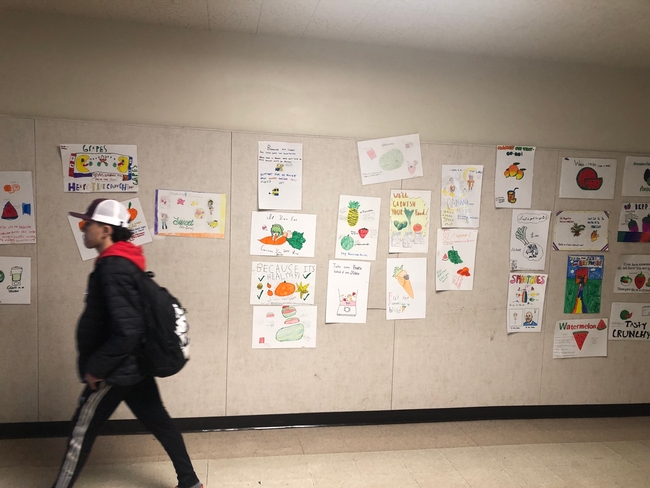
The Issue
Food and beverage companies invest over $1 billion in marketing each year to advertise their food products to Black and Hispanic consumers, specifically the youth. Students at Hillview Jr. High School (HJHS)–which is located in a low-income neighborhood of Pittsburg and has a 60% Hispanic and 19% African American student population– are not exempt from these widespread and targeted food marketing campaigns. Fast food restaurants, convenience stores, and gas stations line the main street avenue near the school, attracting hungry teens.The easy availability and promotion of these foods, which are linked to negative life-long consequences, influence the food choices made by youth every day. When hunger strikes, healthy eating and active living are out of sight and out of mind to many teens.
How UC Delivers
CFHL, UCCE in Contra Costa County partnered with HJHS to deliver EatFit during the 2022-2023 school year. EatFit is a nutrition education goal-setting curriculum designed to challenge middle school students to improve their eating and fitness choices. The program reached 149 students who participated in activities focused on goal setting, nutrition facts label, energy, breakfast, exercise, fast food, and the media's influence on food choices.

In one of the EatFit lessons, students learned about food marketing. They were asked to name a commercial or ad on the Internet about water or healthy food. None could. However, when asked for examples of fast food or soda ads and commercials, all hands went up. Some students even sang the jingle or acted out the commercial. Students realized that food companies target young people and hardly promote healthy foods. Instead, TV commercials and advertisements on the Internet and social media try to persuade teens to eat and drink unhealthy foods and sugary beverages that harm their health. In the same lesson, students also learned about food marketing techniques and were encouraged to create fruit and vegetable posters to promote healthy choices at school.
With support from the principal, the school's busiest hallways were decorated with students' colorful fruit and vegetable posters. Not one poster was vandalized or torn off.
The Impact
One hundred and seventeen students in grades 6-8 completed the Eating and Activity Tool for Students (EATS) pre-post survey at Hillview Jr. High to assess changes in their behaviors after participating in the FY 2023 EatFit lesson series. Respondents were ten to thirteen years old, and identified as Latino or Hispanic (48%), Black or African American (18%), or more than one race (27%). After taking part in EatFit, the student survey results included the following:
- 34% increased the number of time they ate fruit yesterday.
- 30% increased the number of time they ate vegetables yesterday.
- 50% reduced the number of times they drank sweetened beverages yesterday - with the largest decreases seen in fruit drinks, soda, and sweetened coffees and teas.
- 40% increased the number of days they were physically active for 60 minutes or more last week.
“One change I made to eat healthier/be more physically active is to exercise/stretch when I wake up and lower how much unhealthy food I eat (high fat food, high calories etc) and start eating more fruits and veggies.” — EatFit Participant
This work is vital in adolescents as they begin to become more independent in the way they think, learn, and interact with food. Likewise, nutrition education intervention efforts in majority Black, Indigenous, and People of Color (BIPOC) communities are of particular importance because these groups have been expressly targeted as potential consumers of nutrient-poor food while also facing barriers to accessing affordable and convenient healthy food. By supporting students to reflect critically on how unhealthy food and beverages are advertised to them and then develop their counter-messages to promote healthy choices, inclusive SNAP-Ed-approved programs like EatFit and others can help improve nutrition behaviors among low-income adolescent Californians and prevent the chances of developing chronic disease later in life.
CFHL, UCCE staff will continue to partner with Hillview Jr. High to deliver quality nutrition education during the 2023-2024 school year. The fruit and vegetable posters made by students serve as a friendly reminder to all that food marketing does not steal your independence; you can still make a healthy, tasty choice.
“Before, I use to just get snacks to eat them but a lot of them were unhealthy and I got cavities. During the lesson we learned that the labels are actually important. Now I check the label to compare and buy the snack that is more healthy. It is working I am more healthy and happy.”— Jacob Ponce, EatFit Participant


